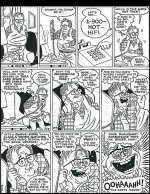john curl said:You have to try them.
Yea, right after I buy a CB radio and get a "handle". I'll call Dick sometime this week.
syn08 said:
On a second thought, I think we have a misunderstanding here. Following your definition of "non-harmonic distortions", any intermodulation product between two uncorellated signals (one could be pink noise) leads to non-harmonic distortions, if it falls within the signal bandwidth. I disagree with this definition of "non-harmonic distortion", in fact, this concept could be as useless as the concept of "linear distortions". BTW, following your definition, is the 19+20KHz IMD test a measure of an amplifier's "non-harmonic distortions"?
I´m still suprised that some common (common as i thought they were) terms are used and interpreted in quite different ways around the world.
I only found a (federal standard? ) for definition here:
http://www.its.bldrdoc.gov/fs-1037/dir-037/_5509.htm
http://www.its.bldrdoc.gov/fs-1037/dir-017/_2542.htm
The definitions for THD and IM-Distorsion rely on different input signal content; while THD uses only one (of course variable) input frequency, IM-tests are made by two or more frequencies.
Therefore in our hypothetical case it is only one fundamental in the input signal, that creates an IM-product, as the second input frequency is a hidden one (in this case caused by jitter).
So the answer to your question would be "no", as a 19+20 kHz IMD test contains two input frequencies.
BTW, regarding the "linear distorsions"; is it really useless to seperate signal alterations that create no spectral content from signal alterations that only change amplitude or phase?
In the end the merit of technical terms is the common meaning- if enough people are convinced the definitions may be changed.
PHEONIX said:
Hello Traderbam
So how to you design, do you have a technical goal , and how do you improve your design.
What reference speaker do you use for evaluation.
Regards
Arthur
Hi Arthur. I now have electrical performance goals that equate with inaudibility of the amp itself. This makes the design process much more focussed and successful.
An issue with speakers is that they have their own sonic signatures and their signature is not independent of the amp used to drive them (they interact). To critically assess an amp by listening requires enough familiarity with the speakers used to be able to discriminate the speaker distortion from the amp distortion. For amplifier evaluation, I think familiarity with the speakers is more important than which speakers you use, provided the speakers are reasonably well designed. The source is much more important; use the best you can sensibly afford.
Brian
scott wurcer said:
Dick Sequerra does spark plugs, Bybee overclocked hot cars. Cars and audio as fetish object it all makes sense now.
Well, you know what they say about men who own big amplifiers...
Jakob2 said:
I´m still suprised that some common (common as i thought they were) terms are used and interpreted in quite different ways around the world.
I only found a (federal standard? ) for definition here:
http://www.its.bldrdoc.gov/fs-1037/dir-037/_5509.htm
http://www.its.bldrdoc.gov/fs-1037/dir-017/_2542.htm
The definitions for THD and IM-Distorsion rely on different input signal content; while THD uses only one (of course variable) input frequency, IM-tests are made by two or more frequencies.
Therefore in our hypothetical case it is only one fundamental in the input signal, that creates an IM-product, as the second input frequency is a hidden one (in this case caused by jitter).
So the answer to your question would be "no", as a 19+20 kHz IMD test contains two input frequencies.
Ok, can you now find the standard definitions for:
a) hidden frequency
b) non harmonic distortion
c) linear distortion
I fail to follow the specifics of the IM product created by "the second input frequency is a hidden one (in this case caused by jitter)."
courage said:One can allways consult the Hi-fi Hotline ....
Had to downsize the picture, but if you open it in a picture viewing program and enlarge a bit it's readable.
This is great, obviously done by an insider who "knows". If you recognize the caricature it's doubly funny. There were some beautiful 300B's at the Akihabara last time I was there ($1500).
We, pioneers of audio design, make our definitions of audio 'deviations' as we go. 'Linear distortion' is one such definition. Works for me!
Just like Otala defined: TIM. It could also be called SID, 'Slope distortion' etc. TIM is just a definition.
'Linear distortion' denotes the effects that dielectric absorption gives you, that is NOT easily measureable with an older type wave or spectrum analyser. This sort of distortion used to be VERY BOTHERSOME to users of analog computers.
We found it somewhat effecting audio listeners, sometimes as a 'sweetener' or 'forgiver' of poorly recorded material. Other times, it deviated the path leading to audio accuracy, and was best, removed.
Just like Otala defined: TIM. It could also be called SID, 'Slope distortion' etc. TIM is just a definition.
'Linear distortion' denotes the effects that dielectric absorption gives you, that is NOT easily measureable with an older type wave or spectrum analyser. This sort of distortion used to be VERY BOTHERSOME to users of analog computers.
We found it somewhat effecting audio listeners, sometimes as a 'sweetener' or 'forgiver' of poorly recorded material. Other times, it deviated the path leading to audio accuracy, and was best, removed.
I have heard the term linear distortion used to represent frequency response variations in the past. That distinguishes it from non-linear distortions. Amplitude dependent frequency response changes would be a bit of a conundrum here, especially if they don't have a corresponding harmonic generation.
scott wurcer said:
This is great, obviously done by an insider who "knows". If you recognize the caricature it's doubly funny. There were some beautiful 300B's at the Akihabara last time I was there ($1500).
300B means B ig?
Size matters!
'Linear distortion' shows up in the 'time domain' more clearly than in the 'frequency demain'. This is why it is so obscure with conventional measurements.
It is more like comparing two graphical images on a screen and noting subtle difference between them, especially if you subtract the two images from each other.
It is more like comparing two graphical images on a screen and noting subtle difference between them, especially if you subtract the two images from each other.
1audio said:I have heard the term linear distortion used to represent frequency response variations in the past. That distinguishes it from non-linear distortions. Amplitude dependent frequency response changes would be a bit of a conundrum here, especially if they don't have a corresponding harmonic generation.
Yes. According to the definition of "linear distortion" a filter is distorting the signal. The notion is obviously important in telecom and other areas where the phase relationships are critical, but to call this a "distortion" in audio is certainly not appropriate.
BTW, I haven't ever seen a shred of evidence about DA inducing linear distortions. To me, this is one of John's pet peeves.
john curl said:Oh come on: MY GENELEX KT88' s are prettier than any 300B's and about as expensive too!
If to use them in phono corrector signal currents can't change temperatures of electrodes so distortions will be minimal!
High current/high transconductance pentodes like 6J52P work there like a charm.
john curl said:Unfortunately, Syn08, you reject any evidence offered, and yet don't offer any counter evidence. It gets tiresome to do many hours of FREE research and measurement, get it published, and then ignored.
Unfortunately JC, you haven't offered anything beyond blank statements. Again, the topic is "DA induces linear distortions".
I have offered you my own work, published in Journal of Applied Physics in the mid 90's, together with references and citations, which clearly proves that DA is fundamentally a nonlinear phenomena, which consequently introduces non linear distortions. Obviously you haven't bothered to take a look, which is not at all suprising given your approach of anything that contradicts your 40 years old experience.
The funny thing is that DA in capacitors that we normally use in audio for signal transmission is modeled by paralleled ideal caps and idealized resistors. This was done by Dow, in the 1950's for analog computer simulation and adopted by Bob Pease (remember him?) on his 1980's paper. DA, the stuff that we ACTUALLY measure, was emulated on SPICE in the early 1980's by Scott Wurcer, who contributes here.
It is true that IT IS A MODEL, but what we actually measure is a deviation of up to 10% or
(-40dB) and the computer simulation closely emulates real measurements, YET the nonlinear distortion is 0, by inspection in the computer model, and normally below -100dB in measurements of real devices. Therefore, there is often a range of 1000 times or MORE deviation from linear distortion and what we measure as nonlinear distortion.
Yet, everyone must know that DA is a physical mechanism, and that by definition, must contain SOME nonlinearity. This appears to be where you come in.
Well, clue us in!
It is true that IT IS A MODEL, but what we actually measure is a deviation of up to 10% or
(-40dB) and the computer simulation closely emulates real measurements, YET the nonlinear distortion is 0, by inspection in the computer model, and normally below -100dB in measurements of real devices. Therefore, there is often a range of 1000 times or MORE deviation from linear distortion and what we measure as nonlinear distortion.
Yet, everyone must know that DA is a physical mechanism, and that by definition, must contain SOME nonlinearity. This appears to be where you come in.
Well, clue us in!
- Status
- Not open for further replies.
- Home
- Amplifiers
- Solid State
- John Curl's Blowtorch preamplifier

